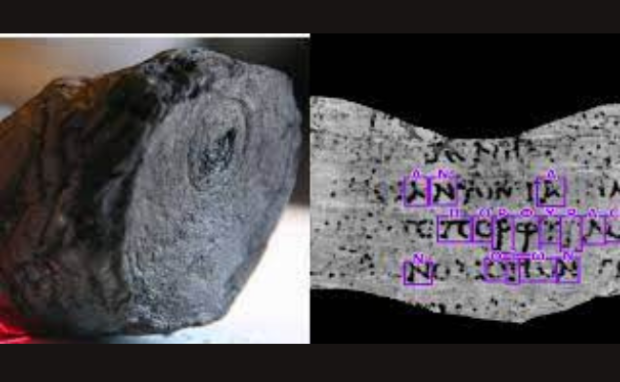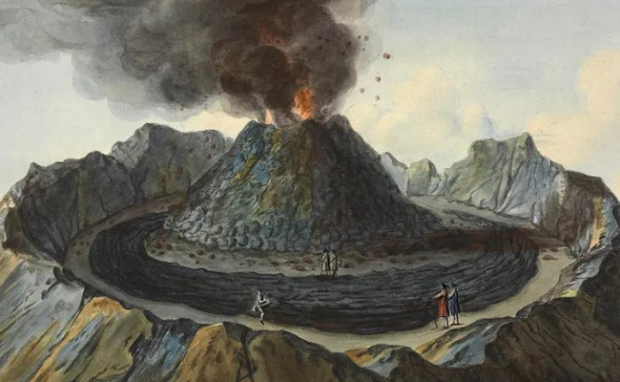AI deciphers first word in 2,000-year-old scroll
Artificial intelligence allowed a 21-year-old computer science student to identify the first word inside an ancient scroll. Luke Farritor used his AI program to decipher the word “πορϕυρας” or “porphyras,” meaning “purple.” One word may seem trivial to most, but it has already piqued the interest of several experts in figuring out its significance.
Modern technology has been helping archeologists locate artifacts and uncover their secrets. Consequently, they help us learn more about our ancient history. For example, experts have been using X-ray imaging and other technologies to reveal unseen marks on paintings and artifacts inside delicate containers.
This article will explain how several experts helped lead to Farritor’s AI scroll discovery. Later, I will give you the background behind this historical record.
How did the AI scroll discovery occur?

Photo Credit: businessinsider.com
The Vesuvius Challenge website explains how the AI scroll research progressed. Later, I will explain what the Vesuvius Challenge is. First, we must discuss how it all began.
In 2019, Professor Brent Seales from the University of Kentucky’s EduceLab imaged Herculaneum scrolls in a particle accelerator, creating high-definition CT scans.
He and his team scanned and photographed detached scroll fragments and detected ink. Later, that success caught the attention of tech entrepreneurs Danial Gross and Nat Friedman.
In March 2023, they started the Vesuvius Challenge, named after the volcano that erupted during the scroll’s early years. They offered a $700,000 Grand Prize and many smaller prizes for developing open-source programs and techniques.
In August 2023, ex-JPL startup founder and polymath Casey Handmer wrote a blog explaining his discovery of a “crackle pattern” resembling ink. Moreover, he found a letter inside the unopened record.
Later, college student Luke Farritor saw Handmer’s crackle pattern sparking Discord conversations. In response, he spent late nights training a machine learning model on the pattern.
Finding new crackles improved the model, triggering a cycle of discovery and refinement. Eventually, the AI scroll algorithm found crackles invisible to the naked eye.
You may also like: ChatGPT experience more valuable than college degree
Then, he submitted his findings to the Vesuvius Challenge for the First Letters Prize, which required contestants to find at least 10 letters in a 4-square-centimeter area.
As mentioned, Farritor found the word “porphyras,” the Greek word for “purple.” Professor Seales claimed, “This word is our first dive into an unopened ancient book, evocative of royalty, wealth, and even mockery.”
“What this particular scroll is discussing is still unknown, but I believe it will soon be revealed. An old, new story that starts for us with ‘purple’ is an incredible place to be,” he added.
What is the scroll’s history?

Photo Credit: apollo-magazine.com
Casey Handmer is one of the people behind the AI scroll discovery who shared the background of the ancient record. His blog says this parchment roll was lost during the Mt. Vesuvius’ eruption in AD 79.
It is one of the most historical natural disasters in history, burying several Roman towns like Pompeii and Herculaneum. Eventually, people rediscovered the scroll in the 1800s inside well-preserved ruins.
In the 1700s, experts found the scroll under six meters of ancient volcanic mudflow at a villa on the Bay of Naples. The destroyed building revealed an extensive network of tunnels containing numerous sculptures.
You may also like: Skeleton could reveal more about Vesuvius eruption
Among them were strange lumps of charcoal, later identified as pyrolyzed scrolls. In other words, they are paper rolls decomposed by extremely high temperatures from lava.
“Some 95% of the material from the classical period, so we just don’t have anything,” said Professor Seales. That is why he and other experts are so determined to uncover information from the burnt scroll.
He shared his ideas regarding what it could contain with The Guardian. “Pliny the Elder explores ‘purple’ in his ‘natural history’ as a production process for Tyrian purple from shellfish. The Gospel of Mark describes how Jesus was mocked as he was clothed in purple robes before the crucifixion,” he pondered.
Conclusion
A college student created an artificial intelligence program that deciphered a word from a 2,000-year-old scroll. The Vesuvius Challenge hopes it could encourage more researchers to uncover its secrets.
Contestants have a chance to win $700,000, but their contributions to historical research will arguably be more valuable. Also, some may develop new tools that advance technology further.
Tech trends are moving so fast they create history at a rate never before seen. Ensure you keep up with these innovations by following Inquirer Tech.